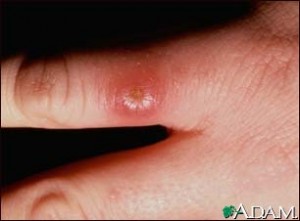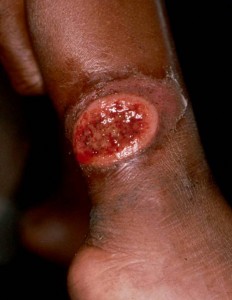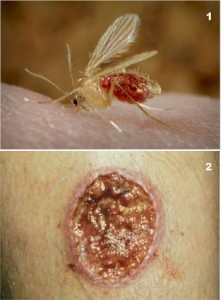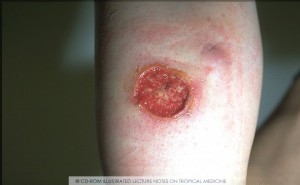Are you suffering from fever and anemia? Having swollen glands and sores on the skin? All these are classic signs of Leishmaniasis. Read on to know what is Leishmaniasis, what causes Leishmaniasis, the symptoms and treatment of Leishmaniasis and whether you are having Leishmaniasis.
Leishmaniasis Definition
Page Contents

Picture 1 – Leishmaniasis
Source – allrefer
Leishmaniasis is a disorder resulting from infection by parasites of the Leishmania variety. There are more than twenty types of Leishmania that can infect human beings. This disease affects internal organs of the body, mucous membranes and the skin. It is also popularly known by many other names like Kala Azar, Black Fever, Espundia, Dum-Dum fever and Sandfly disease.
Leishmaniasis disease is very common in underdeveloped nations but rare in developed countries such as the Western nations.
Where Is Leishmaniasis Found?
In humans, the common Leishmaniasis locations are arms, legs or face. But the sores can arise on any area of human body covered by skin including the genitals.
Types of Leishmaniasis
Leishmaniasis in humans is mainly of four kinds. These are :
Localized Cutaneous Leishmaniasis

Picture 2 – Cutaneous Leishmaniasis
Source – ucsf
This is marked by the appearance of itchy sores and swelling of lymph nodes on arms, legs or face. Over time, the sores develop a red raised border and a depression in the middle. These may heal with time or affect and damage surrounding tissues.
Diffuse Cutaneous Leishmaniasis
The condition is characterized by the development of itchy sores all over the body. The sores are similar to Localized Cutaneous Leishmaniasis lesions and yet different as they appear not in a localized region but all over the body.
Microcutaneous Leishmaniasis
The sores in this condition heal only to reappear years later in uncomfortable regions of the body like nose, mouth and genitals. The new sores damage underlying tissue and cause a lot of pain. These can be infected by bacteria at a later stage. The condition can also give rise to other symptoms such as anemia, fever and weight loss.
Visceral Leishmaniasis
This is the most serious kind of Leishmaniasis and marked by the appearance of lesions on the skin. The skin surface becomes grayish and Leishmania protrozoa travel through the bloodstream to affect spleen, liver, bone marrow and lymph nodes.
Leishmaniasis Symptoms
Some of the main symptoms of Leishmaniasis are :
Skin Sores
The disease is mainly characterized by the development of itchy sores on the skin.
Swollen lymph Nodes
The inflammation of lymph nodes is another common symptom of this disorder. The inflammation may be limited to a particular area of the body such as in Localized Cutaneous Leishmaniasis or spread over the entire body as in Diffuse Cutaneous Leishmaniasis.
Fever
People with Leishmaniasis often suffer from higher body temperatures. This is seen in case of Microcutaneous Leishmaniasis.
Weight Loss
Sufferers of Visceral Leishmaniasis also have a rapid loss of weight.
Swollen Organs
People with Visceral Leishmaniasis may suffer from an enlarged liver or spleen.
Anemia
Leishmaniasis visceral patients are also affected by anemia. The blood cell count suffers a rapid drop in such people which leads to fatigue and impairs daily activities.
Oral Lesions
Sufferers of Microcutaneous Leishmaniasis are also seen to have painful lesions in the mouth.
Leishmaniasis Causes
Leishmaniasis is caused by parasitic infection, mainly by parasites of the Leishmania genus which are carried by a blood-sucking insect known as the sandfly.

Picture 3 – Leishmaniasis Photo
Source – gorillasguides
When the sandfly bites a human or an animal, the parasite is transmitted from the insect to body of the victims and tries to infect the system. The immune system of the body tries to resist the infection by producing immune cells called macrophages that try to engulf the protozoa.
This is proved futile as the Leishmania protozoa can survive the attack and multiply inside the macrophages. Sometime later, the macrophages burst due to internal pressure and Leishmania protozoa begin to affect the neighboring cells leading to an infection.
The severity of infection depends on the type of protozoa and what kind of response it evokes from the immune system of the host.
Leishmaniasis Diagnosis
Leishmaniasis is diagnosed by physical observation and laboratory examinations. An experienced medical professional can tell the disease from observation of the skin sores.
In some cases, samples of marrow, skin lesions, lymph nodes and spleen are taken in slides and tested. Biopsy of the skin, spleen and lymph nodes may be carried out.
Blood tests may also be carried out to check if the sufferer has a reduction in blood cell count. In a few cases of Leishmaniasis testing of the serum may also be done.
Leishmaniasis Treatment
Leishmaniasis can be cured but the medicines for its treatment is expensive. The most common medication for this disease is a course of injections consisting of Meglumine Antimoniate and Sodium Stibogluconate. For treatment of Leishmaniasis drugs consisting of Fluconazole, Pentamidine and Amphotericin B are also being used. Leishmaniasis vaccines are still being developed.
In severe cases of Cutaneous Leishmaniasis treatment involves plastic surgery, such as in patients suffering from disfiguration due to sores arising on the face. People who have a drug resistance but are suffering from Visceral Leishmaniasis have to get a Splenectomy to have their affected spleen removed.
Leishmaniasis Complications
Leishmaniasis can give rise to serious complications. In some people, the entire immune system may be compromised due to deadly infections. The facial area may be damaged and disfigured due to Leishmaniasis sores. The condition may also lead to hemorrhagic bleeding in some sufferers.
Leishmaniasis Prevention
You can prevent Leishmaniasis transmission by using these simple methods.
Applying Repellent
Applying sandfly repellent creams on the exposed areas of your skin can keep the insects away and protect you from its bites.
Screening Windows
Hanging screening nets on your windows can help keep sandflies away from your home.
Put Mesh Net
Putting nets made of fine mesh around the bed can let you sleep peacefully without fearing about sandfly bites. This is especially recommended in areas where cases of Leishmaniasis outbreaks are higher. Take a net along if you are travelling to an area with Leishmaniasis history.
Leishmaniasis Pictures
Want to know if you are really having Leishmaniasis or not? Check out these Leishmaniasis images. Compare the sores on your body with those in the Cutaneous Leishmaniasis pictures given here.

Image 4 – Leishmaniasis Picture
Source – ispub

Image 5 – Picture of Leishmaniasis
Source – wikimedia
If you are having Leishmaniasis atients in your home or suffering from the disease yourself, seek medical treatment as fast as possible. A timely call to the doctor can keep your health safe and prevent a lot of discomforts and complications in future.
References:
https://health.google.com/health/ref/Leishmaniasis
http://en.wikipedia.org/wiki/Leishmaniasis
http://www.wisegeek.com/what-is-leishmaniasis.htm
http://www.wrongdiagnosis.com/l/leishmaniasis/intro.htm

I went to work in Trinidad little over a yr. ago I was bitten by sandfly’s many of times my legs had quarter to nickel size sores face too. I was extremely sick and I Stacie Fallin still today 03/15/11 stuggle being sick with Infection Induced Neurophty they say, I have an appt. with a Neuro. Dr. at the Mayo Clinic in a few days, but I really think there is more to this. I still get the sores on my face and in my mouth and my nose has alot more drainage than before all this started! I need answers I need Drs. that are willing to help me get the right testing done and put this behind me! Can you help me? Sincerely,Stacie Fallin.
I think you should go back to the country you were infected in they will have the right daignosis and cure.the UK and other first wotld countries lack knowledge when it comes to parasitic infections.so your best bet is going back to the source for the cure.
Lismanias is now being found all over the world. There are two strains “old world” and “new world”. I live in Canada but was bitten by a parasite in Cuba October 2016. At first I thought it was a mosquito bite , but it looked very different from those I get back home. The bite was a red center and really itchy. The medical doctor on the resort confirmed it was a mosquito bite and arranged to get an antihistamine to ease the itching. About three weeks after returning home I became very sick with infections starting in the bladder and ending up in the bloodstream. I was immediately given antibiotics by intervenors for the following week. The week following I started breaking out in abscesses on my arms and legs. They look exactly like the pictures of leishmaniasis . Up to now I had no idea of this dsease. It is now March 2018, and after five biopsies, numerous antibiotic med and creams, cortisone ointments, several blood culture tests and still no diagnosis. Today my dermatologist injected each individual sore still refusing to consider leishmaniasis. I wait each day for sores to appear on my face and I am not sure I have the strength to deal with the visual effects that will result in.
Contact the Centers for Disease Control in the U.S. I read a book called The Lost City of the Monkey God and it is eye opening about the researches and how ill they got from this disease. There are very few places that know how to recognize and deal with this. Insist on a skin punch biopsy for identification. The CDC may know what lab test is required for this but you need treatment as soon as possible. This stuff can kill.
Hi Cheryl, I am having the same problem and nobody will take me serious. What happened when it affects your blood stream?
I’ve had excellent success in curing an abscess by placing a raw potato over area and using an ace bandage or tape to hold in place while I sleep. By morning abscess is gone and potato is black. Amazing!